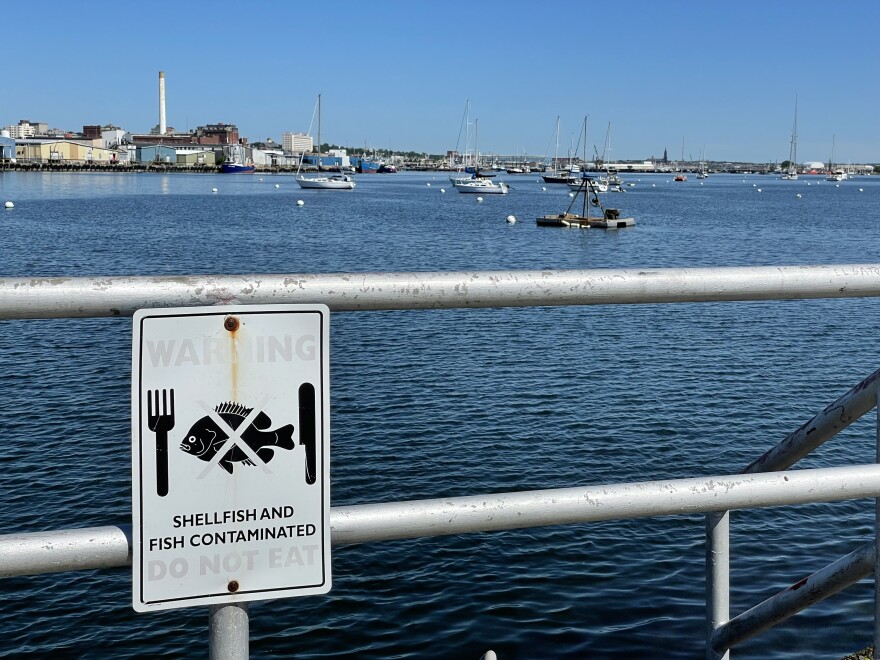Stephen Theberge grew up a few blocks from the New Bedford harbor, and his memory of the waterway in the 1980s isn’t pretty.
“It was abysmal,” said Theberge, recalling the sight (and smell) of raw sewage and garbage lapping the shores where he used to fish. One image still sticks with him: “The striped bass’ gills would be black with all that pollution.”
The black coating on the fish gills was a buildup of polychlorinated biphenyls—PCBs—carcinogens that have plagued the harbor and its wildlife since the 1940s.
These days, Theberge says the water is looking clearer. Sometimes he can see clear down to the bottom of the harbor. “When I was young and going out on a boat—I don’t remember that.”
The turnaround is thanks to a decades-long cleanup by the Environmental Protection Agency. Now in its final stages, the effort has removed one million cubic yards of PCB-laden sediment—enough to bury a football field 500 feet deep—and brought a renewal of animal life to the harbor. But experts caution that trace amounts of PCBs could linger, impacting the health of the ecosystem for years to come.
‘It’s really blossomed’
For much of the 20th Century, New Bedford’s dockside factories used the PCBs to manufacture electrical components. Chemical spills and sewer discharges flushed high concentrations of the pollutant directly in the harbor, according to Wendy Heiger-Bernays, an environmental health scientist at Boston University.
“We usually talk about parts per billion, or parts per million,” said Heiger-Bernays. But in the New Bedford harbor “there were places where there were parts per thousand—concentrations of PCBs that, to best of my knowledge, we've never seen anywhere else in the environment. These were incredibly high.”
In 1979, the state advised residents not to eat fish caught in the harbor—an irony given New Bedford’s longstanding status as America’s most lucrative commercial fishing port. (New Bedford-based vessels catch seafood well offshore of the contaminated harbor.)
In 1983, the EPA tagged the harbor as a superfund site, a designation the agency reserves for the worst polluted industrial areas. It was the first, and to date the largest, marine site in the superfund program.
Since then, the government has invested more than $1 billion dollars in cleansing the harbor of PCBs. About one third of that funding has flowed from a 2013 settlement with AVX Corporation, a corporate successor of one of the polluting manufacturers.
The bulk of the cleanup has involved dredging. The EPA has sent about 600,000 cubic yards of contaminated sediment to a PCB landfill in Michigan. Another nearly 400,000 cubic yards were dredged and then stored in a disposal cell beneath the harbor itself.
Now, crews have finished dredging the navigable portion of the harbor, and the remaining cleanup is focused on the marshes that fringe the waterway’s upper reaches.
“We dig it all up,” says Dave Dickerson, who oversees the cleanup for the EPA. “But then we have to replace it and rebuild the salt marshes. Invariably, everyone comments about the renewal of animal life—fishes and fish-eating birds. We have an eagle that we see routinely here.”
Claudia Warrington, who lives near a marsh along the east side of the harbor in Fairhaven, has noticed the change. “It’s really beautiful. We see egrets and herons and all kinds of waterfowl,” she said. “It’s really blossomed.”
Once the marsh dredging is complete, New Bedford plans to build a park along the water. “The Riverwalk will be a glorious asset that will enhance the neighborhoods in the North End, as well as draw visitors,” says Jon Mitchell, the city’s mayor.
‘Has the EPA removed enough?’
Despite the harbor’s vast improvement since the 1980s, some don’t see a clear path to a completely restored, PCB-free waterway.
Settlement funding has run dry, which Mitchell worries could drag out the cleanup’s final stages for another decade. “We need federal funding to get it done faster than we are now,” said Mitchell. “That’s the most important thing.”
Meanwhile, most of the harbor’s fish are still unsafe to eat.
The nonprofit Community Economic Development Center maintains a seafood safety outreach effort. Workers like Ken Rapoza routinely visit local fishing hotspots, carrying fliers in English, Spanish and Portuguese. “I try to educate people about the pollution that’s still in the harbor,” says Rapoza. “I teach them not to eat the fish.”
The outreach is important, since PCBs can linger in the bodies of animals even after PCB levels in the sediment are reduced.

“I believe that this harbor will never be fishable,” says Heiger-Bernays, who has monitored the waterway for more than 20 years. In addition to the fish, she’s concerned about the potential for PCBs to volatilize and affect local air quality, as well as the stability of the underwater disposal cell where much of the contaminated sediment is stored.
“The efforts and the cleanup have been tremendous,” says Heiger-Bernays. “We should not underestimate that.” But she adds that years of continued monitoring are needed to ensure the health of the harbor and those living nearby. “The question is: has [the cleanup] gone far enough? Has the EPA removed enough?”








